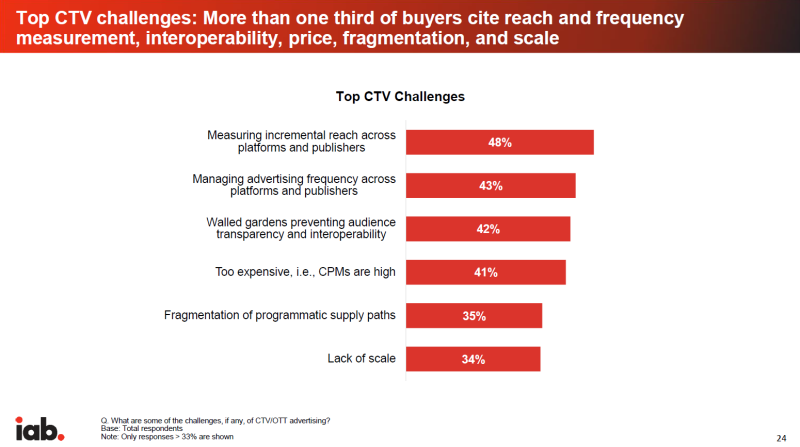Connected TV (CTV) was the driving force behind 2021 digital ad spending, which increased 49% to $39 billion, according to an IAB report released today. The report, published in partnership with Advertiser Perceptions and Standard Media Index Insights, surveyed 406 anonymous respondents.
CTV ad spend alone rose 57% last year – to $15.2 billion – and is projected to more than double over the next couple of years. Findings showed 76% of video buyers consider CTV a “must buy” in their media planning budgets, as CTV allows them to leverage data not available within linear TV. That includes data pertaining to first-party brands, location and shopping.
Buyers also cited transparency and privacy protection as key factors for CTV ad spend. According to the report, 59% of buyers said they were “very clear” on where their CTV ads ran, compared to confidence in ads for social video and other digital video – 50% and 43%, respectively. Moreover, as CTV doesn’t rely on third-party cookies, buyers can more effectively spend ad dollars. Of the video buyers surveyed, 73% expect to reallocate dollars from linear TV to fund mobile ID deprecation CTV spending increases.
Viewer-wise, IAB expects CTV will account for 36% of total time spent with linear TV and CTV combined in 2022. A March report from video intelligence company NPAW showed TVs made up 41% of global VOD device share in hours in Q4 2021.
Although the CTV landscape is surging with marketers and viewers alike, there isn’t enough CTV ad spending to support that growth, the report noted. Only 18% of total video ad dollars are being spent on CTV out of total video spend.
“The amount of dollars currently allocated to CTV is not proportionate to the amount of viewer time spent with the channel,” said Eric John, VP of IAB Media Center, in a statement. “The time is now for brands and buyers to follow consumer attention.”
The report goes on to say disproportionate ad spending suggests buyers face hurdles with CTV ad reach as well as with measuring sales lift, which respondents considered the highest key performance indicator (KPI) desired for CTV.

Sales lift hurdles include “poor attribution tools and methods” and lacking “quality of measurement and modeling,” as some respondents cited.
Despite these challenges, nearly 90% of surveyed buyers anticipate CTV and linear TV marketplaces will converge, with 42% expecting that to occur within the next two years. Two-thirds of linear TV and digital video buyers have formed combined video planning teams, preparing for the paradigm shift.
John added a marketplace convergence could help improve subpar tool functionality and data lags for digital ads.
“Fragmentation continues to be the Achilles heel for buyers,” he said. “As the industry continues to advance and CTV prevails, advertisers are looking toward a converged marketplace that addresses these issues and helps measure the implementation of a variety of creative and targeting tactics.”